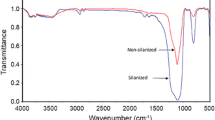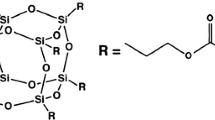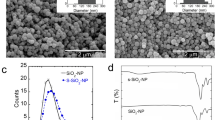Abstract
Mechanical properties of an experimental dental composite filled with spherical silica nanoparticles, in two different particle sizes, were investigated. The experimental results of elastic modulus and strength of the composites were compared with the prediction of models. Amorphous silica nanoparticles (ASN) with primary particle sizes of 12 nm (ASN12) and 40 nm (ASN40) were surface treated by 3-(methacryloxypropyl) trimethoxysilane (γ-MPS). Surface treatment of the particles was examined by FTIR spectroscopy and TGA. The composites were prepared by incorporating of the silanized ASN12 or ASN40 particles in different percentages into a mixture of 2,2-bis-[4-(2-hydroxy-3-methacryloyloxy-propoxy)phenyl]-propane (bis-GMA), triethyleneglycol dimethacrylate and a photoinitiator system. The pastes were transferred into the molds and light-cured. Diametral tensile strength (DTS), flexural strength and flexural modulus of the composites were then determined. The cross-section area of the fractured specimens and dispersion pattern of the fillers throughout the resin matrix were studied by SEM and TEM, respectively. Data were analyzed and compared using ANOVA and Tukey’s HSD tests at a significance level of 0.05. An increasing trend was observed in the flexural modulus of the composites as a function of their filler content. The same trend, however, was not observed for DTS and flexural strength properties. At the same filler fraction, the nanocomposites containing ASN12 showed significantly higher modulus than the nanocomposites filled with ASN40. The models which have been developed for prediction of modulus in the composites with rigid particle in non-rigid matrix fitted better with the experimental values.









Similar content being viewed by others
References
Xia Y, Zhang F, Xie H, Gu N (2008) Nanoparticle-reinforced resin-based dental composites. J Dentistry 36:450–455
Foroutan F, Javadpou J, Atai M, Rezaie H (2011) Mechanical properties of dental composite materials reinforced with micro and nano-size Al2O3 filler particles. Iran J Mater Sci Eng 8:25–33
Tanimoto Y, Kitagawa T, Aida M, Nishiyama N (2006) Experimental and computational approach for evaluating the mechanical characteristics of dental composite resins with various filler sizes. Acta Biomater 2:633–639
Halpin J (1969) Stiffness and expansion estimates for oriented short fiber composites. J Compos Mater 3:732–734
Mitsuhashi A, Hanaoka K, Teranaka T (2003) Fracture toughness of resin-modified glass ionomer restorative materials: effect of powder/liquid ratio and powder particle size reduction on fracture toughness. Dent Mater 19:747–757
Masouras K, Akhtar R, Watts DC, Silikas N (2008) Effect of filler size and shape on local nanoindentation modulus of resin-composites. J Mater Sci Mater Med 19:3561–3566
Junior R, Adalberto S, Zanchi CH, Carvalho RVd, Demarco FF (2007) Flexural strength and modulus of elasticity of different types of resin-based composites. Brazil Oral Res 21:16–21
Rahim T, Mohamad D, Ismail AR, Akil HM (2011) Synthesis of nanosilica fillers for experimental dental nanocomposites and their characterisations. J Phys Sci 22:93–105
Fu S-Y, Feng X-Q, Lauke B, Mai Y-W (2008) Effects of particle size, particle/matrix interface adhesion and particle loading on mechanical properties of particulate–polymer composites. Compos Part B Eng 39:933–961
Atai M, Pahlavan A, Moin N (2012) Nano-porous thermally sintered nano silica as novel fillers for dental composites. Dent Mater 28:133–145
Bourkas G, Prassianakis I, Kytopoulos V, Sideridis E, Younis C (2010) Estimation of elastic moduli of particulate composites by new models and comparison with moduli measured by tension, dynamic, and ultrasonic tests. Adv Mater Sci Eng 2010:891824. doi:10.1155/2010/891824
Mitra SB, Wu D, Holmes BN (2003) An application of nanotechnology in advanced dental materials. J Am Dent Assoc 134:1382–1390
Beun S, Glorieux T, Devaux J, Vreven J, Leloup G (2007) Characterization of nanofilled compared to universal and microfilled composites. Dent Mater 23:51–59
Ilie N, Hickel R (2009) Investigations on mechanical behaviour of dental composites. Clin Oral Investig 13:427–438
Kushch VI, Mogilevskaya SG, Stolarski HK, Crouch SL (2013) Elastic fields and effective moduli of particulate nanocomposites with the Gurtin-Murdoch model of interfaces. Int J Solid Struct 50:1141–1153
Curtis A, Palin W, Fleming G, Shortall A, Marquis P (2009) The mechanical properties of nanofilled resin-based composites: characterizing discrete filler particles and agglomerates using a micromanipulation technique. Dent Mater 25:180–187
Adachi T, Osaki M, Araki W, Kwon S-C (2008) Fracture toughness of nano-and micro-spherical silica-particle-filled epoxy composites. Acta Mater 56:2101–2109
Pukánszky B, Maurer FH (1995) Composition dependence of the fracture toughness of heterogeneous polymer systems. Polym 36:1617–1625
Antonucci JM, Dickens SH, Fowler BO, Xu HH, McDonough WG (2005) Chemistry of silanes: interfaces in dental polymers and composites. J Res National Inst Stand Technol 110:541–558
Ahmed S, Jones F (1990) A review of particulate reinforcement theories for polymer composites. J Mater Sci 25:4933–4942
Cramer N, Stansbury J, Bowman C (2011) Recent advances and developments in composite dental restorative materials. J Dent Res 90:402–416
Iso E (2000) 4049 Dentistry-polymer-based filling, restorative and luting materials. International Organization for Standardization, Geneva
Mirmohammadi H, Kleverlaan CJ, Feilzer AJ (2009) Rotating fatigue and flexural strength of direct and indirect resin-composite restorative materials. Am J Dent 22(4):219–222
Junior SAR, Ferracane JL, Bona ÁD (2008) Flexural strength and Weibull analysis of a microhybrid and a nanofill composite evaluated by 3-and 4-point bending tests. Dent Mater 24:426–431
Goyal R, Tiwari A, Negi Y (2008) Microhardness of PEEK/ceramic micro-and nanocomposites: correlation with Halpin-Tsai model. Mater Sci Eng A 491:230–236
Hu H, Onyebueke L, Abatan A (2010) Characterizing and modeling mechanical properties of nanocomposites-review and evaluation. J Miner Mater Charact Eng 9:275–319
Chen M-H, Chen C-R, Hsu S-H, Sun S-P, Su W-F (2006) Low shrinkage light curable nanocomposite for dental restorative material. Dent Mater 22:138–145
Mohsen N, Craig R (1995) Effect of silanation of fillers on their dispersability by monomer systems. J Oral Rehabil 22:183–189
Ekworapoj P, Magaraphani R, Martin DC (2002) Heat effect on viscosity and curing of light-cured dental resin and mechanical strength of conventional dental composites. J Metal Mater Miner 12:39–50
Zhang H, Zhang Z, Friedrich K, Eger C (2006) Property improvements of in situ epoxy nanocomposites with reduced interparticle distance at high nanosilica content. Acta Mater 54:1833–1842
Einstein A (1956) Investigations on the theory of the Brownian movement. Courier Dover Publications, USA
Hsueh CH, Becher PF (2005) Effective viscosity of suspensions of spheres. J Am Ceramic Soc 88:1046–1049
Guth E (2004) Theory of filler reinforcement. J Appl Phys 16:20–25
Affdl J, Kardos J (1976) The Halpin-Tsai equations: a review. Polym Eng Sci 16:344–352
Kerner EH (1956) The elastic and thermo-elastic properties of composite media. Proc Phys Soc Sec B 69:808
Nakayama WT, Hall DR, Grenoble DE, Katz JL (1974) Elastic properties of dental resin restorative materials. J Dent Res 53:1121–1126
Nielsen LE (2003) Generalized equation for the elastic moduli of composite materials. J Appl Phys 41:4626–4627
Landel RF, Nielsen LE (1993) Mechanical properties of polymers and composites. CRC Press, USA
Le Bourhis E (2008) Glass: mechanics and technology. Wiley, New York
Mooney M (1951) The viscosity of a concentrated suspension of spherical particles. J Colloid Sci 6:162–170
Fu SY, Feng XQ, Lauke B, Mai YW (2008) Effects of particle size, particle/matrix interface adhesion and particle loading on mechanical properties of particulate–polymer composites. Composites 39:933–961
Fu S-Y, Hu X, Yue C-Y (1998) A new model for the transverse modulus of unidirectional fiber composites. J Mater Sci 33:4953–4960
Counto UJ (1964) The effect of the elastic modulus of the aggregate on the elastic modulus, creep and creep recovery of concrete. Mag Concrete Res 16:129–138
Ishai O, Cohen L (1967) Elastic properties of filled and porous epoxy composites. Int J Mech Sci 9:539–546
Paul B (1959) Prediction of elastic constants of multi-phase materials. No. TR3. Brown Univ Providence, USA
Danusso F, Tieghi G (1986) Strength versus composition of rigid matrix particulate composites. Polymer 27:1385–1390
Levita G, Marchetti A, Lazzeri A (1989) Fracture of ultrafine calcium carbonate/polypropylene composites. Polym Compos 10:39–43
Pukánszky B, Turcsányi B, Tudos F (1988) Effect of interfacial interaction on the tensile yield stress of polymer composites. Interfaces in polymer, ceramic and metal matrix composites. Elsevier, Amsterdam, pp 467–477
Turcsanyi B, Pukanszky B, Tüdõs F (1988) Composition dependence of tensile yield stress in filled polymers. J Mater Sci Lett 7:160–162
Acknowledgments
We are grateful to Ms. Samiei and Mr. Ebrahimi in Kooshan Pars Quality Company for their expert technical assistance in mechanical analysis.
Author information
Authors and Affiliations
Corresponding author
Rights and permissions
About this article
Cite this article
Barghamadi, H., Atai, M., Imani, M. et al. Effects of nanoparticle size and content on mechanical properties of dental nanocomposites: experimental versus modeling. Iran Polym J 24, 837–848 (2015). https://doi.org/10.1007/s13726-015-0369-5
Received:
Accepted:
Published:
Issue Date:
DOI: https://doi.org/10.1007/s13726-015-0369-5




